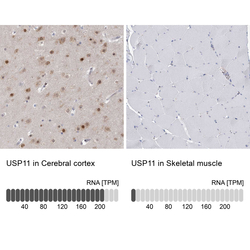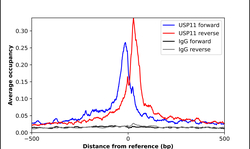Antibody data
- Antibody Data
- Antigen structure
- References [1]
- Comments [0]
- Validations
- Immunohistochemistry [1]
- Chromatin Immunoprecipitation [1]
Submit
Validation data
Reference
Comment
Report error
- Product number
- HPA037536 - Provider product page

- Provider
- Atlas Antibodies
- Proper citation
- Atlas Antibodies Cat#HPA037536, RRID:AB_10672904
- Product name
- Anti-USP11
- Antibody type
- Polyclonal
- Description
- Polyclonal Antibody against Human USP11, Gene description: ubiquitin specific peptidase 11, Alternative Gene Names: UHX1, Validated applications: ChIP, IHC, Uniprot ID: P51784, Storage: Store at +4°C for short term storage. Long time storage is recommended at -20°C.
- Reactivity
- Human, Mouse
- Host
- Rabbit
- Conjugate
- Unconjugated
- Isotype
- IgG
- Vial size
- 100 µl
- Concentration
- 0.2 mg/ml
- Storage
- Store at +4°C for short term storage. Long time storage is recommended at -20°C.
- Handling
- The antibody solution should be gently mixed before use.
Submitted references Regulation of XPC deubiquitination by USP11 in repair of UV-induced DNA damage.
Shah P, Qiang L, Yang S, Soltani K, He YY
Oncotarget 2017 Nov 14;8(57):96522-96535
Oncotarget 2017 Nov 14;8(57):96522-96535
No comments: Submit comment
Supportive validation
- Submitted by
- Atlas Antibodies (provider)
- Enhanced method
- Orthogonal validation
- Main image

- Experimental details
- Immunohistochemistry analysis in human cerebral cortex and skeletal muscle tissues using HPA037536 antibody. Corresponding USP11 RNA-seq data are presented for the same tissues.
- Sample type
- Human
- Protocol
- Protocol
Supportive validation
- Submitted by
- Atlas Antibodies (provider)
- Main image

- Experimental details
- ChIP-Exo-Seq composite graph for Anti-USP11 (HPA037536, Lot 000003359) tested in K562 cells. Strand-specific reads (blue: forward, red: reverse) and IgG controls (black: forward, grey: reverse) are plotted against the distance from a composite set of reference binding sites. The antibody exhibits robust target enrichment compared to a non-specific IgG control and precisely reveals its structural organization around the binding site. Data generated by Prof. B. F. Pugh´s Lab at Cornell University.
 Explore
Explore Validate
Validate Learn
Learn Immunohistochemistry
Immunohistochemistry